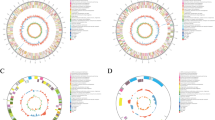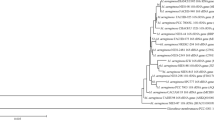Abstract
Planktonic cells of Sinorhizobium meliloti, a Gram-negative symbiotic bacterium, display autoaggregation under static conditions. ExpR is a LuxR-type regulator that controls many functions in S. meliloti, including synthesis of two exopolysaccharides, EPS I (succinoglycan) and EPS II (galactoglucan). Since exopolysaccharides are important for bacterial attachment, we studied the involvement of EPS I and II in autoaggregation of S. meliloti. Presence of an intact copy of the expR locus was shown to be necessary for autoaggregation. A mutant incapable of producing EPS I displayed autoaggregation percentage similar to that of parental strain, whereas autoaggregation was significantly lower for a mutant defective in biosynthesis of EPS II. Our findings clearly indicate that EPS II is the essential component involved in autoaggregation of planktonic S. meliloti cells, and that EPS I plays no role in such aggregation.



Similar content being viewed by others
References
Alami Y, Achouak W, Marol C, Heulin T (2000) Rhizosphere soil aggregation and plant growth promotion of sunflowers by an exopolysaccharide-producing Rhizobium sp. strain isolated from sunflower roots. Appl Environ Microbiol 66:3393–3398
Bahat-Samet E, Castro-Sowinsky S, Okon Y (2004) Arabinose content of extracellular polysaccharide plays a role in cell aggregation of Azospirillum brasilense. FEMS Microbiol Lett 237:195–203
Battisti L, Lara JC, Leigh JA (1992) Specific oligosaccharide form of the Rhizobium meliloti exopolysaccharide promotes nodule invasion in alfalfa. Proc Natl Acad Sci USA 89:5625–5629
Beringer JE (1974) R factor transfer in Rhizobium leguminosarum. J Gen Microbiol 84:188–198
Casse F, Boucher C, Julliot S, Michel M, Dénarié J (1979) Identification and characterization of large plasmids in Rhizobium meliloti using agarose gel electrophoresis. J Bacteriol 113:229–242
Ditta G, Stanfield S, Corbin D, Helinski DR (1980) Broad host range DNA cloning system for gram negative bacteria: construction of a gene bank of Rhizobium meliloti. Proc Natl Acad Sci USA 77:7347–7351
Finan TM, Hartwieg EK, LeMieux K, Bergman K, Walker GC, Signer ER (1984) General transduction in Rhizobium meliloti. J Bacteriol 159:120–124
Glazebrook J, Walker GC (1989) A novel exopolysaccharide can function in place of the calcofluor-binding exopolysaccharide in nodulation of alfalfa by Rhizobium meliloti. Cell 56:661–672
Glazebrook J, Walker GC (1991) Genetic techniques in Rhizobium meliloti. Methods Enzymol 204:398–418
González JE, Reuhs BL, Walker GC (1996) Low molecular weight EPS II of Rhizobium meliloti allows nodule invasion in Medicago sativa. Proc Natl Acad Sci USA 93:8636–8641
Her GR, Glazebrook J, Walker GC, Reinhold VN (1990) Structural studies of a novel exopolysaccharide produced by a mutant of Rhizobium meliloti strain Rm1021. Carbohydr Res 198:305–312
Hoang HH, Becker A, González JE (2004) The LuxR homolog ExpR, in combination with the Sin quorum sensing system, plays a central role in Sinorhizobium meliloti gene expression. J Bacteriol 186:5460–5472
Kaci Y, Heyraud A, Barakat M, Heulin T (2005) Isolation and identification of an EPS-producing Rhizobium strain from arid soil (Algeria): characterization of its EPS and the effect of inoculation on wheat rhizosphere soil structure. Res Microbiol 156:522–531
Keller M, Roxlau A, Weng WM, Schmidt M, Quandt J, Niehaus K, Jording D, Arnold W, Puhler A (1995) Molecular analysis of the Rhizobium meliloti mucR gene regulating the biosynthesis of the exopolysaccharides succinoglycan and galactoglucan. Mol Plant Microbe Interact 8:267–277
Leigh JA, Signer ER, Walker GC (1985) Exopolysaccharide-deficient mutants of Rhizobium meliloti that form ineffective nodules. Proc Natl Acad Sci USA 82:6231–6235
Matthysse AG, Marry M, Krall L, Kaye M, Ramey BE, Fuqua C, White AR (2005) The effect of cellulose overproduction on binding and biofilm formation on roots by Agrobacterium tumefaciens. Mol Plant Microbe Interact 18:1002–1010
Meade HM, Long SR, Ruvkun GB, Brown SE, Ausubel FM (1982) Physical and genetic characterization of symbiotic and auxotrophic mutants of Rhizobium meliloti induced by transposon Tn5 mutagenesis. J Bacteriol 149:114–122
Mendrygal KE, González JE (2000) Environmental regulation of exopolysaccharide production in Sinorhizobium meliloti. J Bacteriol 182:599–606
Morris CE, Monier JM (2003) The ecological significance of biofilm formation by plant-associated bacteria. Annu Rev Phytopathol 41:429–453
Neyra C, Sadasivan L (1985) Flocculation in Azospirillum brasilense and Azospirillum lipoferum: Exopolysacharides and Cyst Formation. J Bacteriol 163:716–723
Nikitina VE, Ponomareva EG, Alen′kina SA, Konnova SA (2001) The role of cell-surface Lectins in the aggregation of Azospirilla. Microbiology 70:471–476
Pellock BJ, Teplitski M, Boinay RP, Bauer WD, Walker GC (2002) A LuxR homolog controls production of symbiotically active extracellular polysaccharide II by Sinorhizobium meliloti. J Bacteriol 184:5067–5076
Reinhold BB, Chan SY, Reuber TL, Marra A, Walker GC, Reinhold VN (1994) Detailed structural characterization of succinoglycan, the major exopolysaccharide of Rhizobium meliloti Rm1021. J Bacteriol 176:1997–2002
Reuber TL, Walker GC (1993) Biosynthesis of succinoglycan, a symbiotically important exopolysaccharide of Rhizobium meliloti. Cell 74:269–280
Rinaudi LV, Giordano W (2010) An integrated view of biofilm formation in rhizobia. FEMS Microbiol Lett 304:1–11
Rinaudi LV, Gonzalez JE (2009) The low-molecular-weight fraction of exopolysaccharide II from Sinorhizobium meliloti is a crucial determinant of biofilm formation. J Bacteriol 191:7216–7224
Rinaudi L, Sorroche F, Zorreguieta A, Giordano W (2010) Analysis of mucR gene regulating biosynthesis of exopolysaccharides: implications for biofilm formation in Sinorhizobium meliloti Rm1021. FEMS Microbiol Lett 302:15–21
Sutherland IW (2001) Biofilm exopolysaccharides: a strong and sticky framework. Microbiology 147:3–9
Zevenhuizen LPTM (1997) Succinoglycan and galactoglucan. Carbohydr Polym 33:139–144
Zhan HJ, Levery SB, Lee CC, Leigh JA (1989) A second exopolysaccharide of Rhizobium meliloti strain SU47 that can function in root nodule invasion. Proc Natl Acad Sci USA 86:3055–3059
Zhan HJ, Lee CC, Leigh JA (1991) Induction of the second exopolysaccharide (EPSb) in Rhizobium meliloti SU47 by low phosphate concentrations. J Bacteriol 173:7391–7394
Acknowledgments
This study was supported by grants from the Secretaría de Ciencia y Técnica de la UNRC, Agencia Nacional de Promoción Científica y Tecnológica (ANPCyT) and Consejo Nacional de Investigaciones Científicas y Técnicas of the República Argentina (CONICET). FS and LVR were supported by a fellowship from the CONICET. WG and AZ are Career Members of CONICET. We are grateful to Dr. Graham Walker for strains, and Dr. S. Anderson for editing the manuscript.
Author information
Authors and Affiliations
Corresponding author
Rights and permissions
About this article
Cite this article
Sorroche, F.G., Rinaudi, L.V., Zorreguieta, Á. et al. EPS II-Dependent Autoaggregation of Sinorhizobium meliloti Planktonic Cells. Curr Microbiol 61, 465–470 (2010). https://doi.org/10.1007/s00284-010-9639-9
Received:
Accepted:
Published:
Issue Date:
DOI: https://doi.org/10.1007/s00284-010-9639-9




